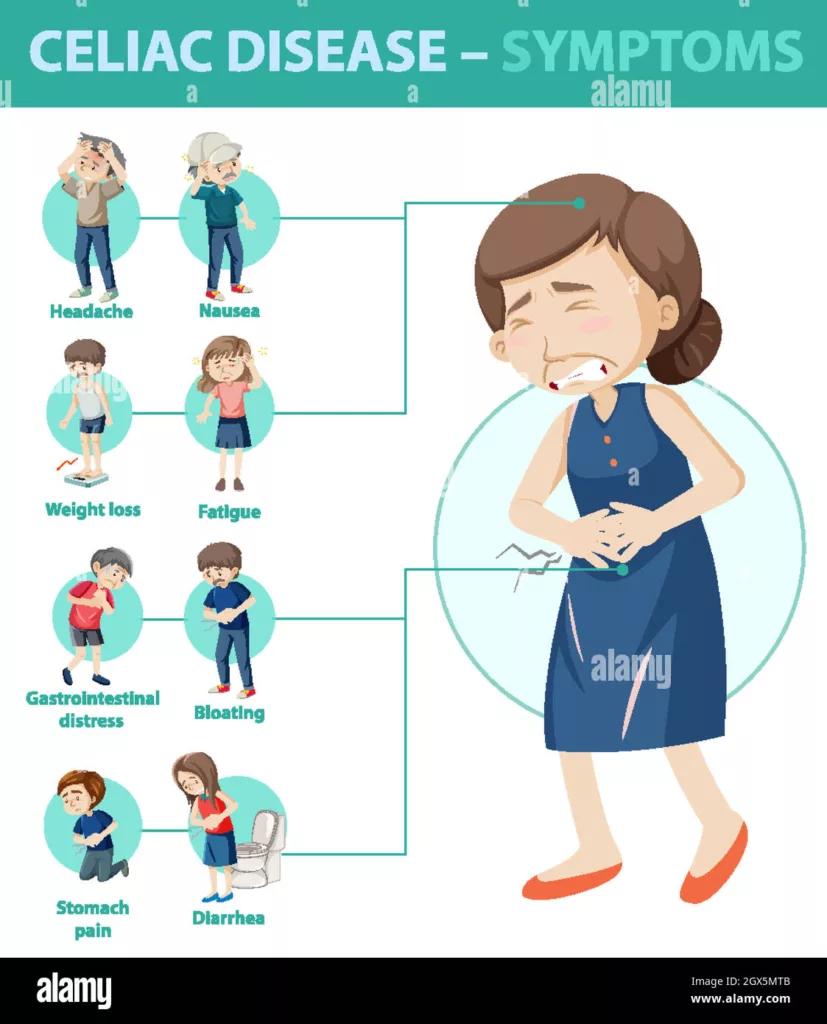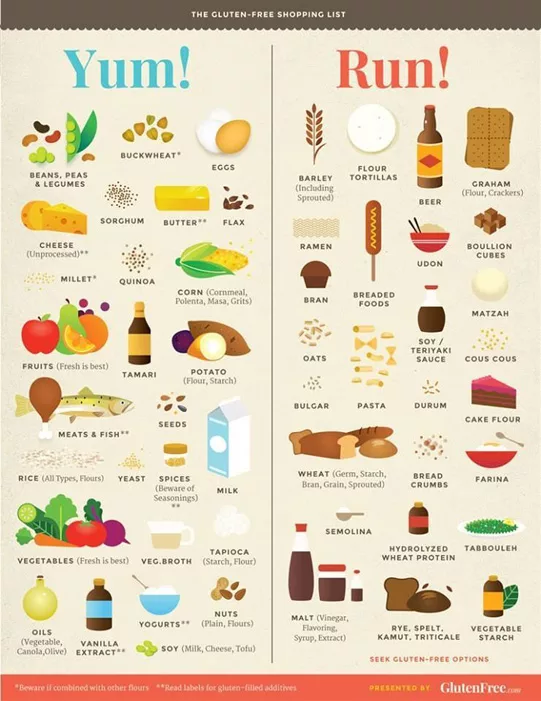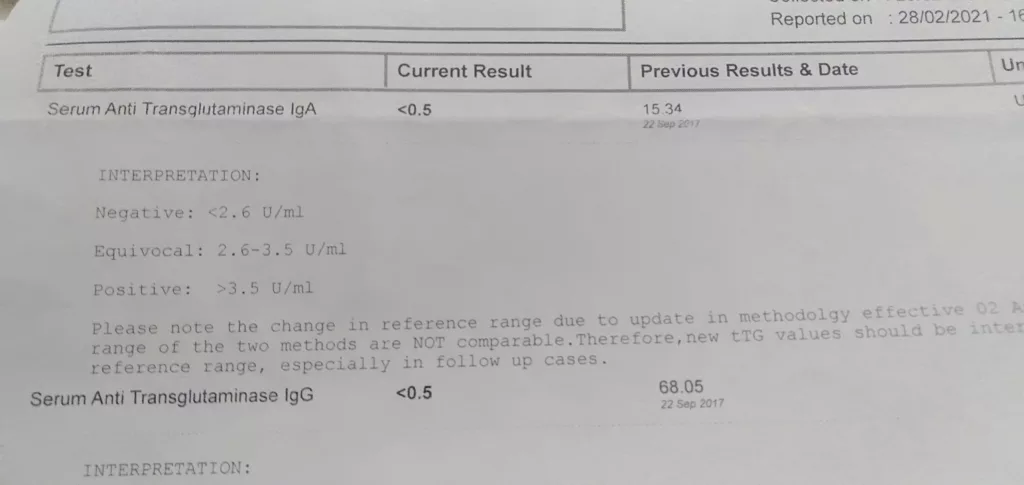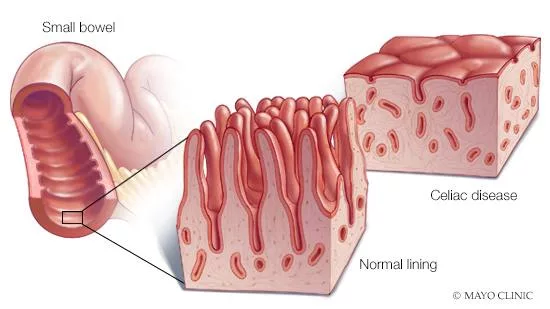Introduction:
Celiac disease that disrupts your immune system. Your immune system damages your tissues. When you eat gluten, it attacks your small intestine, causing your body to react differently. Due to this, your body is deprived of nutrients.
Celiac disease is also known as wheat🌾 allergy, I assume you meant “wheat allergy.” A wheat allergy occurs when the immune system reacts abnormally to proteins found in wheat. The immune system mistakenly identifies certain proteins in wheat, such as gluten or gliadin, as harmful invaders. When a person with a wheat allergy consumes wheat or wheat-containing products, their immune system releases antibodies called immunoglobulin E (IgE) in response to these proteins. This triggers the release of various chemicals in the body, such as histamine, which leads to allergic symptoms.

1. What are the causes of celiac disease?
Celiac disease is caused by a negative reaction to gluten. A dietary protein found in 3 types of grains:
- Wheat
- Barley
- Rye
Gluten is also found in these types of food
- Pasta
- Cakes
- Breakfast cereals
- Certain types of sauces
- Most types of bread
- Some ready meals

2. Symptoms of celiac disease
Consuming gluten-containing foods can cause a variety of gut symptoms, including:
- Diarrhea
- Stomach aches
- Bloating and farting (flatulence)
- Indigestion
- Constipation
- Coeliac disease can also cause
- Fatigue and weakness.
- Weight loss or difficulty gaining weight.
- Skin problems
- Joint pain.
- Anemia due to iron deficiency.
- Mouth ulcers.
- Nausea and vomiting.
- Depression or anxiety.
- Headaches.
- Missed menstrual periods.
- more general symptoms, including:
- Unintentional weight loss is also a problem.
- Dermatitis herpetiformis is an itchy rash. Infertility is a problem.
- Damage to the nerves (peripheral neuropathy) is a problem.

3۔ I can provide you with some guidelines regarding wheat allergies:
Understanding Wheat Allergy:
Wheat allergy is an immune system response to proteins found in wheat, such as gliadin, gluten, and albumin. It can trigger allergic reactions when these proteins are ingested or inhaled.
Symptoms:
Symptoms of wheat allergy can vary and may include hives, rash, itching, swelling, difficulty breathing, nasal congestion, gastrointestinal distress, and in severe cases, anaphylaxis.
Diagnosis:
If you suspect a wheat allergy, consult an allergist. They will perform skin prick tests, blood tests, and possibly an elimination diet to determine if wheat is the cause of your symptoms.
Avoiding Wheat:
The primary treatment for wheat allergy is strict avoidance of wheat and wheat-containing products. Read ingredient labels carefully, and be aware of hidden sources of wheat like sauces, soups, and processed foods.
Wheat-Free Diet:
Opt for alternatives like rice, quinoa, oats (if certified gluten-free), corn, and potatoes. There are also gluten-free flours available, such as almond, coconut, and rice flour.
Cross-Contamination:
Cross-contact with wheat is a concern. Make sure to clean surfaces, utensils, and cookware thoroughly when preparing wheat-free meals. Be cautious when dining out to ensure that your food isn’t contaminated with wheat.
Educate Others:
Inform friends, family, and caregivers about your wheat allergy, so they can take necessary precautions when cooking or providing food.
Emergency Plan:
If you experience severe reactions, carry an epinephrine auto-injector (EpiPen) as prescribed by your doctor. Learn how to use it properly and ensure it’s accessible at all times.
Check Food Labels:
Learn to read food labels to identify wheat-derived ingredients, such as wheat starch, modified food starch, and vital wheat gluten.
Restaurant Dining:
When eating out, communicate your allergy to restaurant staff. Ask about ingredients, preparation methods, and the potential for cross-contamination.
Educate Yourself:
Stay informed about new food products and their ingredients, as formulations can change. Join online support groups or forums to exchange information with others dealing with wheat allergies. Regular Check-ups:
Regularly visit your allergist to monitor your condition and discuss any changes or concerns. Remember, everyone’s allergy is unique, so it’s crucial to work closely with a healthcare professional to develop a personalized plan that suits your specific needs. If you suspect a wheat allergy, consult a medical professional for proper diagnosis and guidance.
Celiac Treatment and Instructions According to Me:

My son was diagnosed with celiac disease at the age of five.
My son was five years old when he started having severe abdominal pain, he started having gas problems, he was not digesting his food, he was vomiting frequently, he was having fever and slowly his weight started to decrease and his iron and Hb levels were rapidly decreasing.
He continued to undergo many treatments, but there was no benefit, he did a blood test with the doctor’s advice, and he was diagnosed with celiac. We were worried that wheat is the only source of nutritional strength, if he do not eat wheat, our child will become very weak. Then first we gave up wheat products and after that we chose wheat substitutes. Initially, it was very difficult for my child to eat rice bread or besan bread instead of wheat bread. Despite using many gluten-free products, my son had colic pains and stunted growth.
After three years of trouble:
After three years of many hardships, we came across a gluten-free bakery in Islamabad Pakistan known as Gluta Non. Thank God my son’s condition has improved day by day since I found this Gluta Non-Bakery. Gluta Non Bakery has a variety of gluten-free flours which have improved my son’s digestive system and improved his growth. I am thankful to Allah and Gluton Free Gluta Non-Bakery in Islamabad Pakistan.
How can medicine cure celiac disease?
There are two types of medicine used for the complete eradication of celiac disease.
- Hikmah
- Herbal treatment

1. Hikmah
With the help of a senior hikma doctor at DHQ Hospital in Sahiwal, Pakistan, complete eradication of celiac disease was possible. Hakeem Sahib diagnosed and treated my son and he was able to eat wheat 🌾.
2. Herbal treatment
I have used two types of herbal treatment
1. Almond, Honey
A total of five almonds should be taken on the first day, one almond should be soaked in water at night and should be dipped in honey in the morning and fed to the child. In the same way, every day one almond should be dipped in honey for eight days, then with the same method, on the ninth day, that is, on the second week, two almonds should be dipped in honey. In the same way, in the third week, three almonds, in the fourth week, four almonds, in the fifth week, soak five almonds in water at night, and in the morning, dip the face in honey and feed it to the child. The next step after completing five weeks, is next week five almonds again i.e. sixth week five almonds seventh week four almonds eighth week three almonds ninth week two almonds tenth week one almond. After 10 weeks of use, the patient will be completely cured.
2. Qahwa /tea
Ingredients: 1. Sonf/fennel
2. Cardamom/ elaichi
3. Mint
Instruction
- 1liter water
- elaichi/cardamom
- mint
- sonf/fennel
Put 2 cardamom seeds and some fennel seeds in one litter of water and boil it and if possible give this water to the patient of celiac disease throughout the day.
How do you follow these instructions daily?
Remember that first in the morning almond Method followed by the ☕Water Method Hakim Medicine and the flour of a good gluten-free bakery following the same method my son is fully recovered. The blood test report show the progress.

Explain in the It link below.
Wheat allergy complete treatment
How to Weight Lose at Home – 15 Easy Healthy Tips





